
An astronomer based in Japan has captured the moment when an unknown object – believed to be a meteor, and possibly one of the Geminids – struck part of the Moon.
The Geminids – first observed lighting up our skies annually in the mid-1800s – are an unusual meteor shower, coming from an asteroid that displays characteristics of a comet.
“The debris causing the Geminids originated from an asteroid known as 3200 Phaethon. After astronomers discovered Phaethon in 1983, they realized the asteroid’s orbit matched that of the Geminid meteors. This pointed to Phaethon as the source of the annual meteor shower. Even though most meteor showers originate from comets, Phaethon was classified as a near Earth asteroid and not a comet,” Serena Whitfield explains in a recent NASA blog.
“On occasion this classification has been challenged, as Phaethon’s orbit is similar to that of a comet and NASA’s STEREO spacecraft in 2009 and 2012 detected a faint tail and rapid brightening around the asteroid’s closest approach to the Sun. As a consequence, some astronomers refer to Phaethon as a ‘rock-comet’, though the term ‘active asteroid’ may be better, as similar objects have been discovered in the main asteroid belt between Mars and Jupiter.”
This annual shower is active from December 4 to 20 in 2024, with this year’s peak occurring from December 13 to 14.
While there is some suggestion that groups of meteors could harbor larger, potentially hazardous objects, for the large part meteors simply burn up in our atmosphere if they are unlucky enough to fall into it. However, as captured by Daichi Fujii, astronomer and curator of the Hiratsuka City Museum in Japan, some of them may instead collide with our moon.
“There was another lunar impact flash tonight. I filmed it at 360fps from my home at 22:34:35 on December 8, 2024 (slow playback) and was able to confirm it with multiple telescopes,” Fujii explained on X, according to the translation. “Bright meteors and fireballs have been appearing every day, but lunar impact flashes have also been captured one after another.”
Fujii captured other potential meteors hitting the Moon on previous nights.
While the Geminids seem a likely cause of the impact, that’s not altogether clear.
“Given the position of the radiant, there is a possibility that these lunar impact flashes are associated with the Geminid meteor shower,” Robert Lunsford of the American Meteor Society told EarthSky. “However, since sporadic meteors still outnumber Geminids in ground-based meteor observations, they may be sporadic meteors.”
Whatever the object was, we’re sure we can all agree it was pretty. Further examples, as well as views of meteors hitting the Earth’s atmosphere, are available on Fujii’s X page.
Source Link: Astronomer Captures Moment Unknown Object Lights Up The Moon